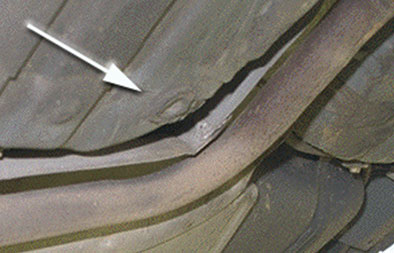|
|
Propagation through Openings
Fire propagates through openings that are available and often creates those openings as it progresses. Openings in the metal bulkhead allow fire to pass from the engine compartment to interior, or vice versa. Bulkhead openings are often found for the heating, ventilating and air conditioning (HVAC) system, the steering shaft, wiring harness, throttle cable, brake and transmission controls, and other accessories. Such openings may be surrounded by a grommet or seal made of flammable material. Some HVAC penetrations are covered by polymeric components that are completely consumed in a major fire. Fire patterns at penetrations can sometimes be interpreted to determine the direction of fire travel (e.g. from the interior to the engine compartment) as in the Dodge van photos below. Openings in the cowl, just below the windshield can be interpreted similarly.
 |
| Ford Explorer engine compartment bulkhead, showing HVAC and wiring openings though which fire propagated to interior. |
The bulkhead of this heavily fire-damaged engine compartment of a 1995 Toyota Camry is at the top of the photograph. Several penetrations are visible showing potential paths for fire. |
 |
| Dodge van non-collision fire engine compartment (after being cut and partially disassembled during salvage after the fire). showing burn pattern that indicates fire initiated behind the bulkhead and propagated through an opening in the bulkhead. Arrow shows direction of propagation. Rusted areas typically indicate regions of high heat where paint is thoroughly consumed by the fire. |
 |
| Dodge van non collision fire, showing damage to steering shaft boot on underside of vehicle. Heat damage to the boot clearly shows fire propagated from left to right through steering shaft hole in bulkhead. |
The arrows show the interior appearance of the grommets sealing the floor pan openings for the steering column (lower arrow) and brake pedal of a 1999 Ford Windstar. |
Burn damage to wiring insulation, carpet, or other polymers immediately on the non-fire side of metal bulkheads or panels can sometimes be caused by transmission of heat through metal panels even though there is no penetration. If the carpeting has been charred, melted or otherwise deformed, then the location can be considered as involved in the fire.
The undercarriage has polymeric plugs (fully covering holes) and grommets (surrounding wiring and controls) that penetrate the passenger compartment and trunk. These plugs and grommets would be some of the earliest materials expected to demonstrate the transmission of fire to or from the passenger compartment.
 The arrow indicates the location of an unburned plug in the floor pan of a 1995 Ford Escort. |
Note that carpeting on the floor and lower areas of the seats are not frequently consumed even in extensive vehicle burns.
Even though the upper half of the passenger compartment had little remaining combustible material, the flooring and lower portion of the driver’s seat foam remained in this 1994 Saturn SL2. More photos of this vehicle are presented in a case study within this section. |
|
|
|